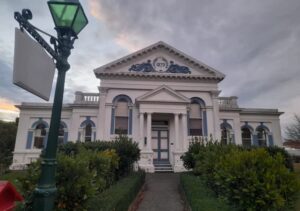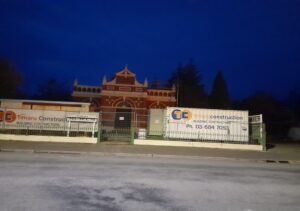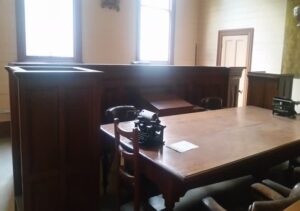1979: Country Courthouse Culling
June 4, 2023
By AHNZ
 On 11 October, 1979, Minister of Justice Jim McLay (National 3.0) dropped the axe on 24 of New Zealand’s country courthouses. Among the fallen was Waimate’s Magistrate’s Court building built in the same year Waimate was proclaimed a borough: 8 September 1879.¹ Many of the other local courthouses were heritage buildings too and at the hearts of their communities so this was a real vivisection on the part of McLay. His excuse was that this was the decision of the Beattie Royal Commission on the Courts (August 1978. And, that a court hearing could be heard in any suitable building according law anyway as if McLay were pretending his court amalgamation would not have practical effect! In reality it was a blow against localism that would culminate in The Great Amalgamation of 1989.
On 11 October, 1979, Minister of Justice Jim McLay (National 3.0) dropped the axe on 24 of New Zealand’s country courthouses. Among the fallen was Waimate’s Magistrate’s Court building built in the same year Waimate was proclaimed a borough: 8 September 1879.¹ Many of the other local courthouses were heritage buildings too and at the hearts of their communities so this was a real vivisection on the part of McLay. His excuse was that this was the decision of the Beattie Royal Commission on the Courts (August 1978. And, that a court hearing could be heard in any suitable building according law anyway as if McLay were pretending his court amalgamation would not have practical effect! In reality it was a blow against localism that would culminate in The Great Amalgamation of 1989.
For Waimate’s old court (image, left) and perhaps the others too, it’s a bit murky as to who ended up owning the rejected building. The Department of Conservation (est. 1987) somehow inherited it, probably from one of the abolished Services it replaced, Department of Lands and Surveys, and insists that it kicked it on down the road to Waimate District Council in 2014. Both the Council and the Waimate Museum and Historical Society are in various stages of denying/refusing that the building, now a museum, is theirs! All this time and still trying to process what Jim McLay did to Waimate. Ref. Confusion surrounds ownership of historic Waimate building, Stuff (2022)
As of 13 October, 1980: Closure of courthouses at Akaroa, Te Aroha, Paeroa, Palmerston, Featherston, Ohakune, Rawene, Fairlie, Cambridge, Otautau, Helensville, Otaki, Motueka, Roxburgh, Milton, Kawakawa, Maungaturoto, and Pahiatua.
As of 31 October, 1980: Closure of courthouses at Hokitika, Patea, Kaeo, Matamata, Waimate and Temuka. Ref. Courthouse closings confirmed, Press (1979,) Papers Past
 In a line that could have come from the 2020s, Labour’s Justice Spokesman Mike Moore said “Judges should be sent to the people, rather than people travelling to the courts. It seemed wrong that’ people should have to travel to courts while there was an energy crisis.” Moore went on to accuse the National Party of ‘centralising everything’ as if his own party were not just as hungry, if not more so, to do that too. Furthermore, when Labour 3.0 had the power they were in the mood to abolish local courts too. Ref. 1862: Warden’s Courts, AHNZ
In a line that could have come from the 2020s, Labour’s Justice Spokesman Mike Moore said “Judges should be sent to the people, rather than people travelling to the courts. It seemed wrong that’ people should have to travel to courts while there was an energy crisis.” Moore went on to accuse the National Party of ‘centralising everything’ as if his own party were not just as hungry, if not more so, to do that too. Furthermore, when Labour 3.0 had the power they were in the mood to abolish local courts too. Ref. 1862: Warden’s Courts, AHNZ
It would be quite interesting to see if these country centers were political targets as an Anarchist would assume they are. For example, Waimate is the home town of Labour’s hero Norman Kirk; Take that! Palmerston is a “district of liberal Scots settlers who named themselves after the Liberal leader” so National may as well torpedo these lefties. Lyttelton no friend of the right either but a cynical interpretation isn’t all about Left vs. Right. Jim McLay, like Jim Bolger, were a new generation nipping at the heels of the old Nats and wanting to power down the Old Boys who came before them. They would be Splitters from Prime Minister Rob Muldoon who himself was a “Young Turk” once and showed willingness to dump National Old Boys Kempthorne Prosser and transfer their fertiliser empire to Ravensdown in 1978. Bolger and McLay’s generation themselves would be nipped in the 1990s by a new ‘Brat Pack’ in turn. In the list of abolished courthouses is Pahiatua which must have pained National Old Boy Keith Holyoake who once protected that territory. So, these sorts of Hit Lists make sense most in terms not of Left vs. Right as much as Us vs. Them.
“The Akaroa Civic Trust wants the old Akaroa courthouse to be preserved….a joint approach to the Department of Lands and Survey regarding the courthouse’s future. The courthouse was closed last year after serving the Akaroa district for nearly 100 years.” – Bid to save courthouse, Press (1980,) Papers Past
““Courthouses that have served their communities, sometimes for more than 100 years, should be given more consideration,” Mr Moore said.” – Press (1980,) Papers Past
“The decision to close 24 smaller courthouses, recom-, mended by the Royal Commission on the Courts, was confirmed yesterday by the Minister of Justice (Mr McLay)” – Press (1980,) Papers Past
“Increasing civil and criminal workloads and growing community pride strengthened the case for a new court house..It was built to the design of the Government architect P.F.M Burrows. It officially opened on Tuesday 9 March 1880,…” – Display panel at Akaroa Museum (accessed 2021)
“The original Waimate Courthouse built in 1866-67 was destroyed by fire in 1878. The present building, designed by architect PFM Burrows was opened in 1880.” – Waimate Together
“The New Zealand Court system is about to be reorganised. Announcing acceptance of many of the recommendations of the Beattie Royal Commission on the Courts (August 1978), the N.Z. Minister of Justice, Mr. J. K. McLay, in August 1979 foreshadowed major changes: Appeals to the Privy Council are to be retained for the time being; The Court of Appeal is to have an additional judge (making five) and in criminal cases will be comprised of two Appeal Court Judges and one High Court Judge; The Supreme Court is to be reconstituted as the “High Court” which, with the Court of Appeal, will be part of the “Supreme Court of New Zealand”; Magistrates’ Courts are to be restructured as District Courts with a civil jurisdiction raised from $3,000 to $12,000; A Family Court is to be created as a division of the District Court; Many procedural and administrative recommendations are to be implemented.”
“The N.Z. Minister’s announcement shows how quickly law reform implementation can happen” – Australian Law Reform Commission – Reform Journal, 1979. Reform 78
“The outsider assumes there is nothing to do in these one-horse towns- in fact there is everything. Voluntary activity runs all, from church groups to those high points of the year, the races and the A. and P. shows. The farmers till the land, their wives cultivate the wilderness of leisure.” – p44, Mitchell (1972)
 The [Sir David] Beattie Report (1978) that McLay wielded contained a timeline section on the erosion of lay magisterial powers. The local magistrates that had served³ New Zealand since its earliest days were in the firing line. So were the Justices of the Peace. It’s probably true that there was much ‘old wood’ and platitudinous posturing old Dandy geezers whose bony hands needed to be pried off the levers of power. But it’s also true that a new Baby Boomer Generation had come of age now and it wanted that power. Ref. Division and Uncertainty, Harkness (2015)
The [Sir David] Beattie Report (1978) that McLay wielded contained a timeline section on the erosion of lay magisterial powers. The local magistrates that had served³ New Zealand since its earliest days were in the firing line. So were the Justices of the Peace. It’s probably true that there was much ‘old wood’ and platitudinous posturing old Dandy geezers whose bony hands needed to be pried off the levers of power. But it’s also true that a new Baby Boomer Generation had come of age now and it wanted that power. Ref. Division and Uncertainty, Harkness (2015)
It was also an attack on these so-called ‘one-horse towns’ and so Voluntarism and Localism. An assault upon the post-War consensus by the kids, now grown up, who were the fairly ungrateful inheritors of it. Ref. Localism, NZB3
Not very long after the Country Courthouse Culling took place Big Government came for the Country Councils too. Maybe it was a necessary step to strip away their local legal organs and the power and money that they represented? Only then was the step wide-open to eliminate and amalgamate New Zealand’s Local Government into a basic and domesticated pet of Wellington. Perhaps if our little towns had not had their courthouses taken away they could have continued to resist The Great Amalgamation on 1989? Ref. 1989: Brian’s Revolution, AHNZ
A useful addendum would be to investigate what happened to these 24, or more, ex-courthouses. Can confirm that Waimate, Akaroa, and Temuka are museums. Cambridge too, however it has just (June 2023) been closed due to the usual post 2011 disease of “Earthquake strengthening.” DOC sold Hokitika’s, currently derelict/under-repair, and then bought it back for $22,000,000 (someone’s making money!) Helensville’s appears to be at their museum now. Rawene’s is a public library. Te Aroha’s now an Arts Centre. Fairlie’s is a private house. If you know more about these courts or others feel free to comment.
—
1 McLintock (1966); Note Waimate founded in 1854. Ref. 2004: Speedgate, AHNZ
2 Powerful brat pack get back together for wake, NZ Herald (2012)
3 Also misserved in parochial or individually criminal ways over the years…
Image ref. Waimate Museum, AHNZ Archives (May 2023)
Image ref. Temuka Museum, AHNZ Archives (May 2023)
Image ref. Cambridge Museum, AHNZ Archives (April 2022)
Image ref. Akaroa’s old courthouse, Akaroa Museum, AHNZ Archives (2021)
Ref. Reading The Riot Act, A 200-Year History of Justices of the Peace in New Zealand, Philip Harkness (2015)
Ref. The Half-Gallon Quarter-Acre Pavlova Paradise, Austin Mitchell (1972)
2 thoughts on "1979: Country Courthouse Culling"
Leave a Reply
 Like Comment Share
Like Comment Share






The psychological effect of locally held trials would help strengthen a sense of local empowerment perhaps?
Yes most certainly. A blow to local identity. And perhaps also to legal expertise because judges could prove their worth on these ‘outter’ circuits. And as another has pointed out the current name suppression (of everything) wouldn’t work if communities saw justice done in their own territory.